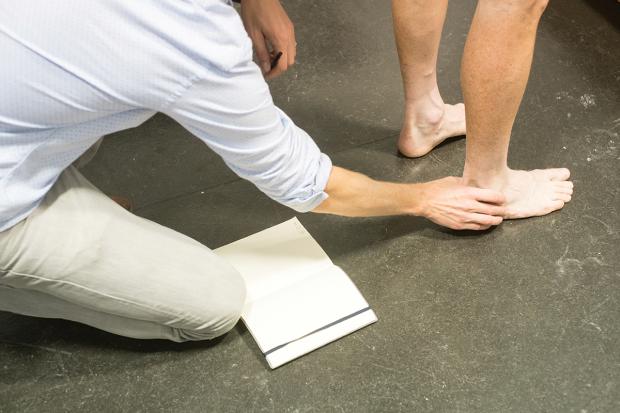Custom foot orthotics
Any insole that offers an increased level of support is probably better than nothing, but the difference between a prefab [off the shelf] and a full custom orthotic is basically on a scale of varying levels of support and specificity. With a full customised orthotic we can consider the foot as forefoot and hind-foot separately and stabilise each accordingly. Mick Habgood.
Customised orthotic inserts for cycling shoes promise more power and fewer injuries. Cyclist discovers whether the claims stand up.

Mick Habgood. CycleFit London.
Stu Bowers, Cyclist 5 October 2015
As any sage will tell you, the key to building something of quality and strength is to get the foundations right. And any bike fitter will tell you that correct bike position and power transfer through your pedals has to begin with the feet.
‘Get this wrong and it’s like the man that built his house on the sand,’ says Mick Habgood, sports podiatrist at Cyclefit, as he talks me through some simple exercises and specific movements while staring intently at my feet. ‘Building on a concrete base is the best situation, and by using customised orthotics we can provide that for your body – a stable, optimally positioned, well-supported platform from which to drive with. The most important aspect of the testing is identifying what type of forefoot the client has and how this position affects the chain of muscular and joint effects at the ankle, knee then hips during each cycling revolution.
‘What’s unique about cycling compared to, say, running is that the variables are much more limited, so what you see in the clinic translates much more into real world scenarios outdoors,’ he adds. ‘The foot remains static and it’s not the sagittal movement [heel to toe] that’s important but the lateral [side to side]. As such, orthotics for cycling are very different as I’m trying to block and balance the foot, not encourage it to move.’

Habgood examines my feet both at rest and during movement. There’s no hi-tech equipment involved at this stage, just his trained eye, a notebook and a pen. Only once he’s finished does the technology arrive. I slip into my cycling shoes, now fitted with wafer-thin, Gebiomized pressure-mapping mats beneath the standard insoles, and climb aboard the fitting jig. ‘We could do this on a turbo trainer, but by using the jig we can quickly dial in your position and also simultaneously check the alignment of your knees using the Dartfish system,’ says Habgood.
As I pedal through a range of intensities, Habgood’s eyes are trained on the monitor, the software providing a real-time, visual representation of the magnitude and spread of pressure my foot is exerting in the shoe. I’m not allowed to see the screen, just in case I’m tempted to alter my natural pedalling style to improve the data. A snapshot of that data is taken and Habgood tells me he’s already certain we can make some improvements, and he produces a disembodied skeleton’s foot to help explain his findings.
‘My goal is to identify asymmetries and to evenly distribute the forces across the entire forefoot from the 1st to the 5th metatarsophalangeal joint (MPJ) so that when you’re attempting to generate maximum power during each pedal stroke you’re not wasting time and energy.’
| Getting plastered |
As Habgood lays strips of wet plaster over my foot, I can’t help admitting that the sensation is rather pleasant. He says, ‘You can use 3D scanning, or take foam impressions or some other weighted impressions, but the reason I do plaster casts with the foot unweighted is because then I’m the one directing what the foot does, not you. When you stand, your foot is not balanced, so not in its neutral position.
The plaster cast moulds of my feet are used to craft the customised orthotics using carbon fibre, a process that takes a few days, so I have to make a return visit for the final part of the process. Orthotics have evolved a great deal over the past decade. Whereas previously they would have been bulky and heavy, modern use of carbon fibre for the structural element means they can now be thin and strong, making them stable and rigid while adding very little weight or bulk to the shoe. I’m eager to find out whether these fancy inserts can actually improve my riding.
‘There are two main things we can aim to improve: pain and performance,’ says Habgood. ‘Everyone’s foot is different. It doesn’t matter what the foot looks like – it’s how much it moves. In the majority of cases people have an elevation of the first ray. That means their big toe MPJ sits higher than the others when the ankle is in its most neutral position. This is called supinatus.
Continue reading in Cyclist
| Fitting Team Drops Cycling. 2.2.16 – Great buzz in Cyclefit – In studio 1 Julian Wall and Shaun Rouse work with Jen George. Meanwhile in Studio 2 Phil Cavell and Mick Habgood (podiatrist) work with Laura Laura Cameron. Typical MDT (multi disciplinary team) approach we like take at Cyclefit – 2 x old timers (Phil & Jules), 1 x Physio and 1 x Podiatrist = SUCCESS! Cyclefit UK. Youtube Feb 2, 2016. |
Also see
The Foot is Prince Cyclefit
The bare truth about flat feet The Mayo News
Put an end to foot and ankle arthritis pain Fit for Life, Dr. John Sigle
For runners, using the wrong orthotics can lead to foot or back pain New York Daily News
For the sake of your feet, pay attention to them! The Poughkeepsie Journal
